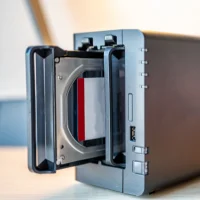In the digital era, effective data management and file access have become critical. Network-attached storage (NAS) arises as a solution that provides users with shared data access while being cost-effective and dependable. This article investigates NAS’s intricacies, including its components and functions.
Understanding NAS is critical for maximizing data storage and retrieval, whether you’re a tech enthusiast or a corporate decision-maker. So, let us go on this adventure into the realm of NAS to discover its full potential. Read on to learn everything you need to know about network-attached storage.
What Is Meant by Network-Attached Storage (NAS)?

Network-attached storage (NAS) is a storage system that connects to a computer network and allows users to access files and data from many computers. It is a low-cost and efficient method of storing and sharing data across various people and devices.
One or more hard disks, a network interface, and a controller are standard components of NAS systems. The controller is in charge of controlling the data on the hard drives and providing network access to the data.
NAS systems are intended to be simple to set up and operate. They are usually set up with a web-based interface allowing users to view and control their data from any device with an internet connection. Furthermore, NAS systems are often outfitted with data backup, encryption, and remote access capabilities.
See Also: 5 Questions Boards Should Ask About Cybersecurity
What Are the Components of NAS?
A NAS device is, at its core, a dedicated storage server—a specialized computer created and intended to handle storage via network access. Every network-attached storage device, regardless of size or scale, is generally made up of four key components:
1. CPU
Every NAS storage device is controlled by a computer with a central processing unit (CPU) and memory. The CPU operates the NAS OS, reads, and writes data to and from storage, manages user access, and, if needed, connects with cloud storage.
Whereas general-purpose CPUs are used in PCs and servers, a dedicated device such as NAS may employ a specific CPU intended for high performance and low power consumption in NAS use cases.
2. Network Interface
Small NAS systems built for desktop or single-user usage may support direct computer connections such as USB or limited wireless (Wi-Fi).
On the other hand, any commercial NAS designed for data sharing and file serving would need a physical network connection, such as a cabled Ethernet interface, to provide the NAS with a unique IP address.
Along with the CPU, this is often regarded as part of the NAS hardware package.
3. Storage
Physical storage, often in the form of disk drives, is required by every NAS. The drives may comprise classic magnetic HDDs, SSDs, or other non-volatile memory devices, and they often support a variety of storage devices.
The NAS may enable logical storage organization for redundancy and performance, such as mirroring and other RAID implementations, but the CPU, not the disks, handles such logical organization.
4. OS
Like any other computer, the operating system (OS) organizes and maintains the NAS hardware, making storage accessible to clients, including users and other programs.
Simple NAS devices may not showcase a particular OS, while more advanced NAS systems, such as Netgear ReadyNAS, QNAP QTS, Zyxel FW, or TrueNAS Core, may.
Why Is Selecting the Right NAS Important?
Choosing the right NAS is critical for various reasons:
- Performance: The performance of various NAS devices varies. The ideal NAS should manage your workload effectively and without bottlenecks.
- Ease of Use: The ideal NAS should be user-friendly, allowing for simple setup and maintenance, particularly for individuals with less technical experience.
- Storage Capacity: The NAS you choose should have enough storage capacity to support your existing data while allowing for future development.
- Support and Reliability: A good NAS device should be manufactured by a respected company that offers dependable customer service and frequent firmware upgrades to keep the device safe and updated.
- Budget: NAS devices are available at a variety of pricing points. Choosing a NAS that falls within your budget while also satisfying your storage requirements is critical.
Must Read: Best Password Managers (Free, Open Source)
The Benefits of Using Network-Attached Storage
NAS has several advantages that make it a vital alternative for data storage.
These advantages range from centralization to scalability, making NAS a complete solution for data management requirements.
- Centralized Storage: NAS provides a substantial benefit by keeping all data in one area and making it available from any network-connected device. This reduces complexity and saves time by removing the need to search various devices or locations for certain files.
- Improved Collaboration: NAS systems are powerful collaboration tools that allow numerous people to view and share data from any place. This improves team or organization cooperation by enabling everyone to work on the duplicate files simultaneously, which is particularly useful in projects requiring several team members.
- Data Security: Organizations must handle data security issues, and NAS systems include encryption and user authentication capabilities. Encryption prohibits unwanted access to sensitive data, even if it is stolen or compromised physically, preserving data integrity and safety.
- Scalability: NAS systems meet the data storage demands of expanding enterprises by allowing for simple scaling, adding new hard drives or expansion units, significantly boosting storage capacity, and ensuring efficient and adaptive solutions for corporate development.
You May Like: Best Malwarebytes Alternatives
Examples of NAS and Its Use Cases
NAS is a flexible system that may meet various data storage requirements. Its uses are many, ranging from small offices to major companies.
Here are a few instances of network-attached storage (NAS) that demonstrate its versatility:
1. Small Business
Small firms often need help with organizing and distributing files among staff. A NAS device can successfully handle this issue.
A NAS device streamlines file administration and improves collaboration by centralizing all company data.
2. Home Office
A NAS device may fulfill numerous functions in a home office setting. It can store personal files, offering a consolidated and readily accessible area for your papers, images, videos, and other media.
A NAS device may also back up data from several PCs. This functionality is beneficial in reducing data loss caused by device failures, accidental deletions, or cyber-attacks.
3. Large Corporation
The data storage requirements of a large company might be enormous. A NAS device may successfully meet these requirements. It can store vast volumes of data and serves as a centralized destination for all business files.
This centralization streamlines data administration and improves data accessibility, allowing staff to view and exchange information more easily.
Related: FreeNAS Alternatives
Conclusion
With its diverse components and user-friendly features, network-attached storage is vital for data storage and access. As our digital requirements grow, the significance of choosing the correct NAS device becomes clearer. Storage space, performance, affordability, convenience of usage, and manufacturer support are crucial factors to consider when deciding.
Furthermore, the advantages of NAS strengthen its position as a complete data management solution. Individuals and companies may simplify their data operations, boost collaboration, and protect their information in an ever-changing digital ecosystem by using the potential of NAS.
Hi there! I’m Nick Cullen. As the Senior Content Editor with Solution Suggest, my responsibility is to scrutinize and refine our articles and reviews, focusing on software solutions, games, apps, and websites. I’m dedicated to delivering reliable and enlightening content that offers viable alternatives to your current digital tools. If you have any suggestions or inquiries, you can reach me at editor@solutionsuggest.com. Also, I invite you to connect with me on LinkedIn!
